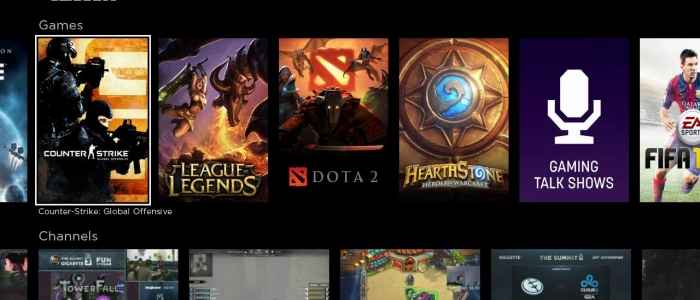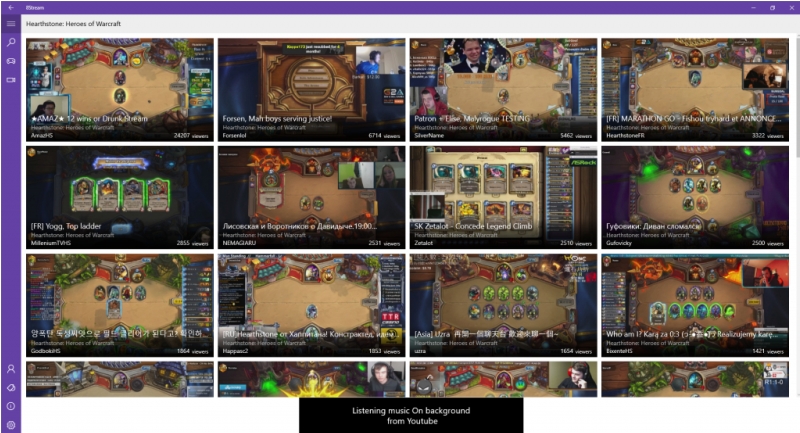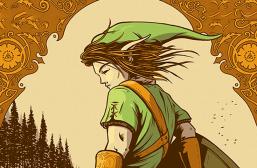Twitch: Gamers Selling Games
Not long after the industrial revolution, the introduction of graphic design into creating logos for private companies and corporations were implemented. By post-World War II, clothing industry realized the ingenious simplicity of stamping their corporate logo onto their attire. Striking the perennial two birds with one stone, the sartorial designers understood its imprint served twin marketing functions.
The first is disseminating brand awareness at point of sale (display rack) as the consumer identifies with the merchandise. When a white cotton t-shirt looked like any other, how could the public tell one manufacturer’s line from the next? As Nike grasped, a large Swoosh on the chest of a t-shirt is unmistakable on the display rack. But it also extended beyond merely differentiating brands, but free residual product recognition. Ambling around with a Nike Swoosh was the classic case of the walking billboard; it was mobile advertising. Essentially, the consumer was indirectly paying the apparel company to market their brand to the outside world. Building on this very concept is consumers dressing up as their favorite fictional characters.

Cue the contemporary multimedia entertainment expos like Comic-Con and AnimeCon. Sartorial creativity and branding transcends a whole new meaning gilded by the rise of cosplay. To the uninitiated, cosplay is a portmanteau of “costume play” devised originally from the world of Japanese animation. As consumers masquerade in costumes representing their favorite characters from a range of multi-genre and multi-medium art forms, media conglomerates realized its vast marketing potential. While the ritual of costuming in these conventions symbolically act as a thread pulling the expo community together, in branding it functions in parallel to the logo imprinted t-shirt. Cosplayers craft homemade costumes as likenesses of these copyrighted characters from the digital screens of film and animation.
Among the different prongs of marketing strategies, anime production companies rely on the familiar principles that Nike realized sometime ago. Professional cosplayers follow the annual convention circuit. While they generate profit through all mediums of media, their role playing advertises the iconic figures that media companies monetize (turn into profitable commodities). In fact, in some cases, these companies realize they can forgo in creating their own living mascots, since it’s all taken care of and advertised by the cosplayer. Similarly, consumer-interactive marketing of corporate brands has spread to online gaming.

What is Twitch.tv?
Splintering off Justin.tv, Twitch.tv adopted the synthesizing of a deceptively simple, but arduous-to-execute concept of grafting live-stream with live chat. A common realization now, the hybrid idea was in its early stages a mere nascent musing. A real-time 24-hour internet broadcasting, conjoined with viewer interaction, was actually the passing reveries of a pioneering tetrad. Amongst the founding four is the site’s eponymous Justin Kan, whose surveilled-life would be inspired by the arch theme of modern reality-based televisual entertainment.
EDtv meets cyberspace, it was an experimental celebration of self as celebrity. In its original webpage mouse-print, their intention was innocuously “to see what it was like to be Justin.” Inspiring digital low-brow’s version of cinéma vérité (fly-on-the-wall documentary filmmaking), Kan was an ear-piece camera with legs. Divvyed into different content types, its gaming category outgrew other streaming materials. Spinning its most publicly favored channel then was its logical conclusion, subsequently being acquired by Amazon.
Twitch stations are mainly mapped around a hodgepodge of digital-gaming titles and a handful of side-interest programming. In lieu of rubbernecking behind a shoulder, Twitch saddles the spectator in the same seat of the gamer. From such established series as the League of Legends, World of Warcraft and Counter-Strike, spectators are spoiled for choices in following other streamers engaging in their favorite digital pastimes around the clock. However, its menu hierarchically shifts based on its viewer numbers. Top-aisle games feature immediately on the scale’s peak. Under-whelming titles fall under the pecking order on the totem pole. Some of these less desirables are buried deep, requiring more turns on the mouse scroll wheel.

Once inside a selected broadcasting title, there emerges a panoptic* panorama of hosting streams transporting the viewer into cells and chambers of the gamer’s living rooms or bedrooms. Once more, the channel hosts ushering in the most subscribers hail supreme, couched on the apex of the gamer’s selection page. Opting a channel typically unveils the host’s gaming screen. What is actually broadcasted online is the very monitor that the gamer herself exercises her split-second motor skills. While monopolizing the audience’s window is the same real-time game play onscreen. Concurrent is a smaller display capturing the gamer’s physical appearance.
While the action of the gameplay unravels, pegged in the corner of the spectator’s monitor is the emotional and verbal response of our immersed host interacting with the featured title. On rare elaborate cases, broadcasters elect a third-adjunct screen. These exceptions are its enviably rich artistic potpourri of its Creative and Music programming. Comprising the montage of screens, music-specific broadcasters include a triad of streaming windows. Each three may individually capture the musical workstation (DAW), themselves (their visage and backdrop) and their hands dexterously manipulating the dual turntable or musical instrument (midi keyboard, guitar, drums, etc.). All the while, the webchat interface allows the audience to communicate with the host. Financially, each monthly subscription is worth around $5.
Persona Sells

The dynamic between the gamer, viewer and the interactive electronic product cultivates a fascinating triangular relationship. For the live streamer, persona is everything. She is both a subject and a digital gamer, synthesizing the dual roles. In fact, as traditional television, radio and filmic personalities, the Twitch broadcaster is in every right – like that of the YouTube vlogger – a carefully crafted personality. In academic nomenclature, they are an online iteration of a meticulously tailored subjectivity. Nominally on the surface, they aspire to project a self-image of an authentic individual, where they can be “themselves,” just playing video games. However, in most cases, they are sophisticated forms of subjects designed with nuanced caricatured traits from popular culture or imagination.
Parody and ironic indifference as comedic personas, or sultry and seductively manicured cosplay characters, an ensemble of invented selves lure subscribers through their engagement with certain titles. Subsequently, a gamer need not be the best performer in their chosen title, as most Twitch streamers are not professional gamers. What allures potential consumers to the title is the outlandish persona as a conduit.
Cartoonish in braggadocio, absurdly dead-pan and exaggeratedly pantomime, Dr. Disrespect is an apt model of a scrupulously devised character. His highly popular channel follows his ridiculously unscripted reaction to Daybreak Game Company’s H1Z1. Handlebar moustache, jet-black mullet, wrap-around shades and a hyperbolic sinister locution, Dr. Disrespect maintains the face of an anachronistic farcical villain. All the while maintaining character, he interacts with both game and viewer. What makes Dr. DisRespect a double threat is not only his comically eccentric character, but his first-person shooting abilities. Depending on the type of game, some highly skilled professional gamers stream faceless. Treating their channel as an instructive clinic, it acts as a workshop for fans to learn tips, tricks and skills, or clues in unlocking a difficult stage. In such exceptional cases, pure gaming competency matters.

As an interactive audio, visual and textual experience, Twitch broadcasts are shrink-wrapped content and packaged for monetizing both identity and computing platform. Screen-to-screen streaming simulates the direct visual and auditory experience of the host. While the host facilitates the action of the game, the subscriber as voyeur (or its more sinister argot of “lurker”) is as close to direct immersion, while lending feedback via the text function. It is here the fourth wall breaks down. The gamer interjects to publicly read enquiries and comments posted on the chat board, thereby responding directly to the subscriber. More powerful than when a protagonist addresses the filmic audience, the streamer is momentarily video-conferencing their follower. Because one of its main theatrical values is the title’s ecosystem, it seamlessly functions as a driving force in marketing digital commodities.
While Hollywood’s studio system is fingered for its racial, ethnic and gender imbalance in representation, Twitch, like YouTube, reinforces the premise that cyberspace is a better-served leveler over other established forms of entertainment. Its accessibility reflects, however a skewed cross-section of US social landscape, but open to a vast ambit of the international community. Indiscriminately interspersed within its general menu, streamers from all continents host specific language-based content.
Yet, to say that Twitch is a likeness of US social cross-section would be disingenuous. African-American, Latinos and markedly senior presence are marginal. However, perhaps per socio-economic factors, Asian-American and Asians are visibly represented. Clearly, it is gender disparity that the streaming space directly readdresses. Hybrid roles of the cosplay gamers particularly gain notoriety by donning the façade of familiar female anime figures. A single cosplayer may shift costumes as she broadcasts their game online, interplaying the world of anime and online gaming.

Like YouTube and its foot solider YouTubers, Twitch gamers freely circulate the logistics in becoming a streamer. Unsurprisingly via YouTube, the established streamer welcomes the public into her bedroom-converted studio, touring through the various logistical kit and gear (type of computer, webcam, USB mic etc.). Meanwhile, a cottage industry emerges in spreading such knowledge by following a Twitch gamer’s footsteps. They are explicit about the type of brand and model that has brought them digital fame. All angles are monetized. Most world-title championships based on a given title is aired live in multiple languages on Twitch. Cited by ESPN, the 2016 League of Legends World Championship finals alone was followed by 43 million people. Viewership of the baseball Worlds Series has not broken the 40 million mark.
Under the stewardship of Amazon, it has birthed its own second-annual convention: TwitchCon. Akin to comic-con as a stage for consumers to double as marketer via masquerading as iconic multimedia characters, Twitch pushes the envelope of this very concept. As a platform converting the enthusiast gamer into its disguised salesperson, the website is a concept beyond the dreams of the marketing department of multimedia corporations. As its recent iteration of 3D broadcast realized in Boom.tv, the consumer is now also the talking and playing three-dimensional digital billboard.
*an aerial view akin to one like a panopticon (a self-surveilling circular prison devised by Jeremy Bentham).
What do you think? Leave a comment.











I’ve been playing games since the commodore 64 and afterburner was the best game out. Since then I’ve practically owned every single console and enjoy the escapism from time to time. Haven’t played much since my first son arrived 4 years ago though. I’m not an online gamer at all, I just don’t enjoy it. I tried it once or twice and I can’t stand the absolute rubbish that comes through my headphones and it’s not really enjoyable being a casual gamer at almost 34 when you do finally have time to play it, everyone is already on level 50.
My girlfriend loves the oldies games like crash bandicoot and the early need for speeds. She absolutely kicks my arse in guitar hero on expert but I always remind I can actually play the real thing.
Good luck to anyone who can make cash out of it.
Perhaps your sentiments explain an absence of a specific age-based cross section within the community of Twitch broadcasters. Outside for reasons of being a luddite or techno ilitterate, you don’t see many personalities above the age of 40 on the website. As for the trolling and puerile traffic, Twitch does a pretty good job monitoring and policing both the airwaves and web chats. As how much the broadcasters want to keep their interaction with their subscribers sanitized, that’s their prerogative.
Here’s CNBC’s look into how much a professional broadcaster earns: “On average, pro-streamers can make between $3,000 to $5,000 per month playing 40 hours a week, just from the “sub button.” That number doesn’t include ad revenue, which averages about $250 per 100 subscribers.”
The Amiga was simply amazing.
And yet seems to be a forgotten era for many – there’s a massive focus on SNES/Megadrive, but the 16-bit home computers are left out.
No one wants to watch someone physically undesirable play COD, unless they’re about to get SWATed.
Particularly the cosplay broadcasters invest in looking attractive. Yes, some are very easy on the eyes. But if you’re one of the few gamers in Twitch who are professionals, then your outer appearance is peripheral, both figuratively and on screen .
Serious question, why would you watch someone playing a game rather than playing it yourself?
Or do you do both simultaneously?
The very question I assumed was rhetorically obvious that led me to realize how wrong my assumptions were. I don’t play video games, but I found myself being drawn to the personalities who were playing the software titles. Like reality television, it seduces you via the limbic portions of the brain (the emotional learning and decision making).
It’s not only video games that Twitch specializes in. The Creative channel has broadcasters displaying a panoply of inventive expressions, from stitching to cooking. Please surf through the website and I’m sure you’ll encounter a hobby that you revel in.
It can be fun watching ( I can only handle a short time) a really skilled person playing, my Aspergers nephew will watch all day rather than play, I cant see the attraction in that myself.
Im still surprised no TV networks have tried to buy the rights to some of the big game events as late night filler material.
It’s intermittently broadcast on ESPN. What’s more, E-sports is to be a medal event in the 2022 Asian Games.
Playthroughs are ok, they’re essentially walk through guides.
H1Z1 tournament aired on the CW Network on Thursday. An e-sports tournament actually aired on prime-time television.
Same reason you would watch a hockey game or football game. You can learn a lot from watching people better than you, not to mention how entertaining these figureheads in the streaming industry can be. Many offer an interactive experience where the watcher can communicate with the streamer and gain advice and simply chat.
Same reason you would watch a hockey game or football game. You can learn a lot from watching people better than you, not to mention how entertaining these figureheads in the streaming industry can be. Many offer an interactive experience where the watcher can communicate with the streamer, gain advice and simply chat.
Watching someone play a video game is even more boring than playing a video game… which is already extremely boring.
People are weird.
But weird is good!
These days gaming and technology is highly accessible and used by pretty much the entire population.
Twitch actually has apps for all mobile platforms and certain streaming media players (like the Amazon Fire TV Stick). Yes, people watch people playing video games on the plane and train.
I couldn’t imagine playing games for a living. As soon as I start to do something for a living, it ceases to be fun.
The curse of professionalizing labor, thereby questioning if one should follow their passions. Perhaps a disappointing road to taking the fun out of the fun.
While there’s truth in that….if you were turning a few mil a year (like some do) you’d probably think differently after a year or two you’d be “set” for life as it were.
I agree. But I’d imagine it’s also a matter of finding the one game you can tolerate playing on a near daily basis.
How much is watching skilled gamers play and how much is gaming eye candy?
Well, the streaming cosplayer-cum-gamer intersects the joy and aptitude of gaming with the titillating “eye candy” of cosplaying. A deadly combination of seducing hormonal teenage boys to reach for the subscribe button.
I have a few female streamers on Twitch I watch regularly (Dizzykitten, Loserfruit, Elspeth, Annemunition etc) and they’re all really cool streamers just chilling out playing games.
It’s sad to see some people in their chats who come up with some terrible stuff just because they’re (presumably) guys watching gamers who just happen to be female. Like some of the stuff is just disgusting. Fortunately their mods are normally on the ball but occasionally in the smaller channels they don’t have enough mods to cope with the trolls.
It’s also sad to see some of the female streamers who dress as provocatively as they can because they know they will get views and potentially donations from previously mentioned guys. I mean, it’s their choice and all – but I personally won’t watch those streams.
From brazen to passive-aggressive racism, sexism and bullying should not be tolerated. You’re right, considering the logistics, the moderators do a competent job in quelling any ugly trolling. As the article states, though, Twitch is a digital space that does fairly well in representing gender balance.
I wonder if there is an audience for me watching people watching video games.
in turn, I would be watching them watching you who is watching people playing video games . . .
A very, very interesting read. As a gamer who can’t game much anymore, watching others play on Twitch is a vicarious pleasure that I like to indulge in from time to time.
I have a doubt about the title though. Shouldn’t it be “Gamers Selling Games”. What exactly is that apostrophe doing there?
Indeed, my error and I take full responsibility with the typo; perhaps I feel everything needs a posession. 😀
I’m glad the article piqued your interest.
Kudos on correcting it. And since I didn’t say this earlier, thanks for this amazing read 🙂
Thank you!
I’ve never seen twitch. So do you get a fpv of their screen, or is it like sky sports news where you are watching pundits watching screens? Or both?
I like games but as you get older it’s harder to justify the time to play yourself, let alone time to watch someone else playing.
Yes, ordinarily, you have a first-person view of gamer’s screen, while a small screen on the margin is a webcam capturing the streamer. Here’s a generic example:
https://blog.twitch.tv/watch-and-chat-in-full-screen-with-theater-mode-321238b7bd38
As for your second sentiment: I wonder time spent on an activity that isn’t economically productive, such as gaming (outside of Twitch streamers), has some long-term therapeutic benefits. For instance, people who enjoy making art and music (or any non-financially lucrative hobby), as merely a recreational activity, realize it has mental health benefits that ameliorates their well-being and mood.
It depends. Most twitch streams are just a stream of their screen (sometimes with overlays etc..) but for bigger e-sports events on Twitch like the Dota 2 majors you will have full studio broadcast with pundits and commentary.
Which will explain why e-sports is popularly incorporated with other mainstream sporting events and televised on ESPN.
Generally, you see exactly what the streamer is playing. More and more, there’s also a “facecam” of the streamer so you can se their reactions and the viewer chatlog is displayed also.
It’s a good way to experience new games when more and more things are vying for our precious time and money.
The expression “facecam” would have been really useful for the article. Thank you nevertheless for enlightening me with the colloquial term.
You see their screen and they usually have a little mini screen with them on it and a chat room sidebar thingy for posting abusive comments.
People wanting to be entertained watch entertaining people. Sure some are immature teenagers, some are trolls, some are academics researching their next paper on “gender divides in modern 21st century digital communications” etc, but most people are just wanting entertainment.
Precisely. One major point of the article is to show that Twitch, like all online commerce sites, are a business. In fact, it’s part and parcel of the entertainment business. What’s ingenious about this business model is it doesn’t have to create its own content. Their subscribers, who are hobbyists and professional gamers, produce the content for the company, in this case Amazon. Moreover, the streamers (who for many were once fan subscribers) convert their subscribers into becoming streamers themselves. Thereby, a pipeline of content, produced by members of website, are doing all the heavy lifting of producing content material. A deviously self-perpetuating cycle!
The live social interaction is a major attraction.
Another quality is that when you play a game you will experience highs and lows, suffering the pitfalls and confusion, the frustration and the elation. Once you have triumphed there is a joy (and some light-hearted schadenfreude) in watching another experience all that, whilst you yourself are at a safe remove.
I guess there are many more reasons people considering buying a game will see gameplay
Indeed, the streamers’ infectious enthusiasm is another allurement for the consumers following their favorite gamers. While guerrilla marketing may resort to the stranger sitting next to you at a bar innocuously lauding the vodka he’s or she’s drinking, it’s obviously less veiled on Twitch.
Also, while we’re on this topic, there’s an atmosphere of fandom or cult of celebrity that pervades similar to how you may follow your favorite sports team. It’s quite amazing how the live chat boards light up when their favorite gamers win a round of H1Z1. The subscribers cheer on as if they themselves have taken home victory.
I would like to speak to anyone from twitch.
Be careful for what thy wish for . . .
Twitch is some serious through the looking glass shiz.
You’re right. It’s voyeuristic as the subscriber is invading the visuals of someone’s screen. Some streamers actually revert to widescreen mode on their facecam, providing a panoramic view of their residential sanctom.
Yeah, black mirror-esque.
The Internet was invented to watch other people experience life.
Which begs the question, isn’t our lives meant to be experienced?
I’m glad that Twitch exists since it gives most game genres a chance to shine. I’m terrible at fighting games, but still buy them to learn them. I don’t have much time to put into fighting games, so at least I get to enjoy tournaments like NorCal Regionals or EVO.
I also usually watch Twitch whenever events like Awesome Games Done Quick or Summer Games Done Quick are on. It’s always fun when you see screenshots of games like Ape Escape and Katamari Damacy getting more viewers than CS:GO or League.
Traditional organized contact sports that are televised (via cable/satellite) will slowly adapt to live side-by-side with e-sports. While Twitch streams large international tournaments centered on flagship game titles, I have a feeling ESPN will launch a channel dedicated to e-sports. E-sports is literally the wild west, with a handful of multimedia and telecommunication companies exploiting a relatively untouched market.
Pretty much the only things in Twitch’s favour at the moment are YouTube’s insane copyright policies and ContentID system, and their historical momentum. The service has been technically awful for a long time, people just lived with it because there wasn’t much option.
Arguably, YouTube’s problems mean that there still isn’t much of an option, but a YouTube shift to a more creator friendly attitude could leave Twitch behind on all fronts.
Your reply is quite apt, because just yesterday, Twitch unlocked its new Affiliate program for their non-partnered streamers so they can access cheering (virtual tipping) to make money. The more user friendly Twitch is for streamers to generate profit-based contents, the greater the distance its competitors are left behind.
Twitch has better monetisation and more of a community. Also it has Kappa.
Again, something new you learn everyday. One of the designations for all those facial emoticons punctuating the chat section is “Kappa.” In this case, the face of Josh DeSeno.
Twitch is really good to play but once i have used kill ping that was very helpful to reduce the ping but I am not sure it is ever good to me or others.
I feel as though Twitch and YouTube allow people to become popular and potentially make money in the process.
Indeed. Both Twitch and YouTube are not merely the product, but it is the marketplace. Moreover, the audience is the actor of the content and vice versa.
Good news!
It’s weird to me how much of the YouTube’s gaming content Twitch has eaten up. Let’s Plays are getting replaced with live streams at an astonishing rate. I think that the primary reason for this massive shift is largely due to the fact that Twitch makes it so much easier for content creators to get paid.
As someone mentioned before in relation to Twitch, YouTube is more constrained by some hurdles in monetizing content. Casey Neistat has already lectured on YouTube’s algorithm for sieving content that can be monetized. Off the cuff, when YouTubers insert copyrighted material (however minimal), YouTube is concerned for obvious litigious reasons that the small slice of the lifted content would lead to lawsuits.
Twitch itself is certainly an interesting forum in many respects. The commercial aspect of it is inherent but it’s inherent in any other form or media as well. The sale of a game with a personal flair is a fascinating dynamic as each streamer becomes a spokesperson for the game they play. I had a friend who was briefly part of a professional team for the MOBA Smite and he was required by the management of his company to stream, as was the rest of his team. I found it interesting how the advertising aspect becomes imperative in this professional gaming context.
When questioned by friends and family about why I watch someone playing a game when I could play it myself, I always found myself unable to explain why. However, one day a friend of mine on the internet said it was akin to watching professional football games on Tv, and I’ve always thought of it in that sense since then. I could go play horror games or brand new games myself, but I often find it boring or too scary. It’s not always the game itself that draw’s me in, it’s more often than not the Twitch streamer that I’m paying to watch. Whilst I enjoy being able to watch a specific Youtube gaming video at any time, I feel there’s merit in the organic live streaming side of Twitch. Being able to interact with people who I find funny or interesting in real time is so astonishing to me, especially when I otherwise would not be able to geographically.
Selling games via Twitch is a great idea. A streamer or video blogger always has a certain number of subscribers who like the game they see and they would like to buy it. What else can I tell… Well done, Twitch! But there is the question whether Youtube will introduce such an option.
Good read. To me Twitch feels like the first iteration of what will be when it comes to streaming, video games, eSports, etc. I’m excited to see where it will be in 3+ years.
The phenomena of this type of programming is an interesting insight to the changing desires and interests of the new generation of viewers and consumers. I agree that the development of personas is part of the core appeal, as in many ways the invention of such systems as Twitch are not that different to an amalgamation of original chat rooms, with the freedom to create a new, “better” personhood online. The aspect that really interests me with this is the creation of a space for the collaboration and connection with others, this is counter to the original accusations thrown at internet use as a solitary and isolationist tool. Such popularity is a positive outcome, but only time will really tell…
This is REALLY interesting.
The stat about the viewing figures of the LoL final getting so many viewers is mind-blowing.
I work in the poker industry and Twitch has become a the first place most operators are looking to spend their marketing budget.
You absolutely nailed it with the statement that personality outstrips skill.
A video game’s marketability through an online broadcasting platform such as Twitch is an interesting facet to mass entertainment and I think any viewership of an otherwise unknown video game can only be beneficial in sales; however, when only a select few games rise to the peak of popularity in live-streaming, not many other games are being exposed.
I’ve been watching Twitch for years, but I remember thinking how bizarre it was when my friends first told me about it. To me, watching Twitch streams is a combination of enjoying professional players play the game well, and being entertained by their own playful personality as they interact with viewers.
It’s crazy how Twitch has expanded into not just a streaming platform for video games, but also for music, art, and “Just Chatting” with viewers who want to tune in. Because of this, the platform has reached a wide range of content creators and consumers alike.
It’s only apt that Amazon acquired Twitch. Amazon will spin off the non-video-game channels on Twitch, such as cooking and music. They’ll respectively expand each themed channel into its larger individual multiverses within its already growing platform.
Not long ago, I found a function in one of Amazon’s tabs that locates the exact date when I first signed up for the website. For me, it was 18 years ago. I was surprised to see that most of my early purchases were books. But you probably just heard me smack my head with my hand, because Amazon began exclusively selling books. Yes, there was a time Amazon was only synonymous with online retailing of that ancient relic. They later discovered the secret recipe of its supply-chain of books can be transferable to any material-based thing existing in our reality, from pins to an industrial-sized lathe (yes, you can actually purchase it on Amazon).
Prior to its acquisition, Amazon realized, “hey! not only can we market video games on Twitch, we can market any product/service via the content-streaming platform. They once asked of their supply-chain system, why stop at books? Now, with Twitch, they’re contemplating why stop at video games? You can already hear the foundations being laid out on Twitch to expand its other non-video-game channels.
Like Amazon with books, your children will one day laugh at Twitch as once being only a video-game streaming website.